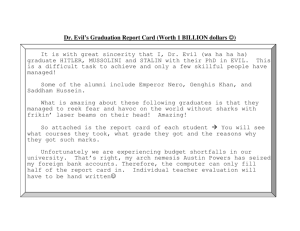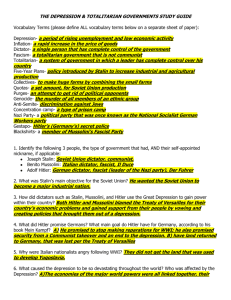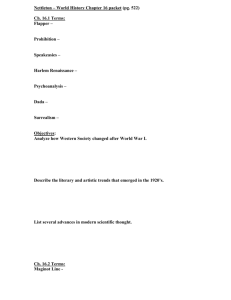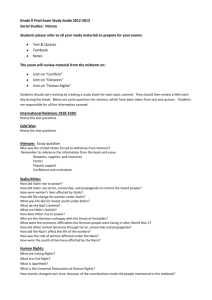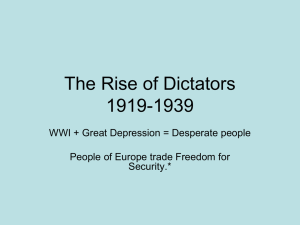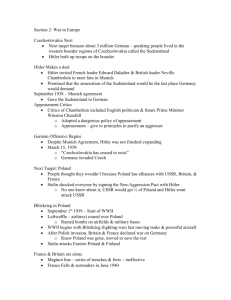Chapter 21- Between the Wars (1919-1939)
advertisement
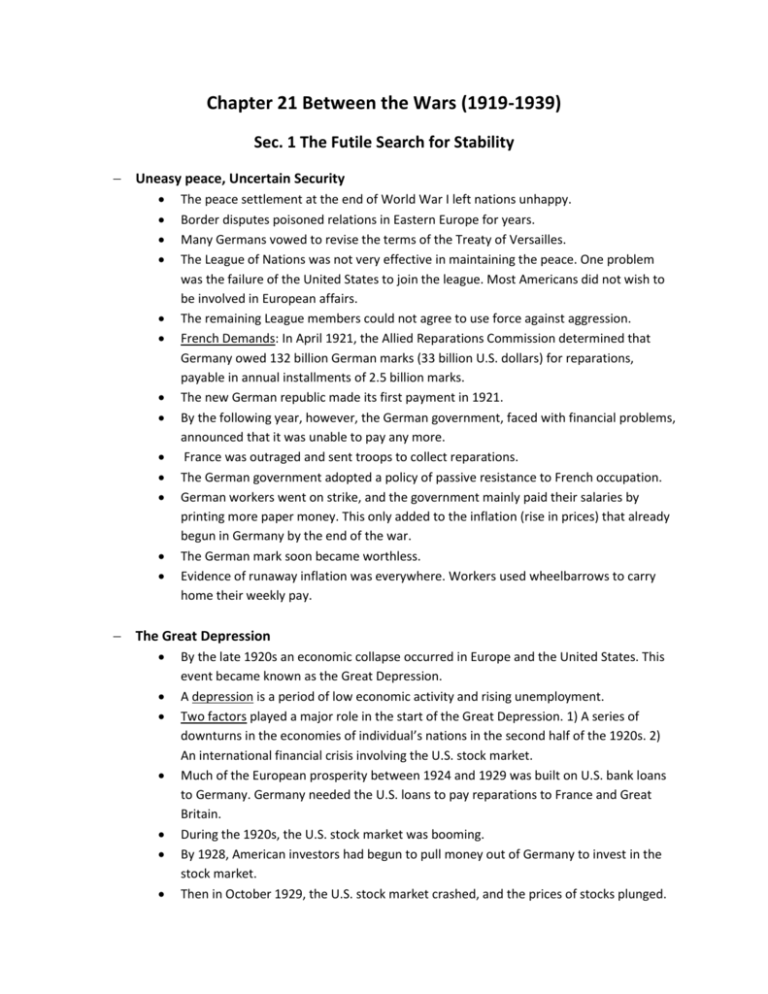
Chapter 21 Between the Wars (1919-1939) Sec. 1 The Futile Search for Stability Uneasy peace, Uncertain Security The peace settlement at the end of World War I left nations unhappy. Border disputes poisoned relations in Eastern Europe for years. Many Germans vowed to revise the terms of the Treaty of Versailles. The League of Nations was not very effective in maintaining the peace. One problem was the failure of the United States to join the league. Most Americans did not wish to be involved in European affairs. The remaining League members could not agree to use force against aggression. French Demands: In April 1921, the Allied Reparations Commission determined that Germany owed 132 billion German marks (33 billion U.S. dollars) for reparations, payable in annual installments of 2.5 billion marks. The new German republic made its first payment in 1921. By the following year, however, the German government, faced with financial problems, announced that it was unable to pay any more. France was outraged and sent troops to collect reparations. The German government adopted a policy of passive resistance to French occupation. German workers went on strike, and the government mainly paid their salaries by printing more paper money. This only added to the inflation (rise in prices) that already begun in Germany by the end of the war. The German mark soon became worthless. Evidence of runaway inflation was everywhere. Workers used wheelbarrows to carry home their weekly pay. The Great Depression By the late 1920s an economic collapse occurred in Europe and the United States. This event became known as the Great Depression. A depression is a period of low economic activity and rising unemployment. Two factors played a major role in the start of the Great Depression. 1) A series of downturns in the economies of individual’s nations in the second half of the 1920s. 2) An international financial crisis involving the U.S. stock market. Much of the European prosperity between 1924 and 1929 was built on U.S. bank loans to Germany. Germany needed the U.S. loans to pay reparations to France and Great Britain. During the 1920s, the U.S. stock market was booming. By 1928, American investors had begun to pull money out of Germany to invest in the stock market. Then in October 1929, the U.S. stock market crashed, and the prices of stocks plunged. In a panic, U.S. investors withdrew even more funds from Germany and other European markets. This withdrawal weakened the banks of Germany and other European states. By then, trade was slowing down, industrial production was declining, and unemployment was rising. Economic depression was by no means new to Europe. However, the extent of the economic downturn after 1929 truly made this the Great Depression. During 1932, the worst year of the depression, nearly one British worker in every four was unemployed. About six million Germans, or roughly 40 percent of the German labor force, were out of work at the same time. The unemployed and homeless filled the streets. Government did not know how to deal with the crisis. One effect of the economic crisis was increased government activity in the economy. This occurred even in countries that, like the United States, had a strong laissez-faire tradition- a belief that government should not interfere in the economy. Another effect was a renewed interest in Marxist doctrine. Marx’s prediction that capitalism would destroy itself through over production seemed to be coming true. Communism thus became more popular, especially among workers and intellectuals. Finally, the Great Depression led masses of people to follow political leaders who offered simple solutions in return for dictatorial power. Everywhere, democracy seemed on the defensive in the 1930s. Lesson 2 Totalitarianism in Italy. The rise of Mussolini The apparent triumph of democracy in Europe in 1919 was extremely short lived. By 1939, only two majors European states-France and Great Britain- remained democratic. Italy, the Soviet Union, Germany, and many other European states adopted dictatorial regimes. These regimes took both old and new forms. A new form of dictatorship was the modern totalitarian state. A totalitarian state is a government that aims to control the political, economic, social, intellectual, and culture lives of its citizens. New totalitarian regimes pushed the power of the central state far beyond what it had been in the past. They wanted to conquer the minds and hearts of their subjects. The first person to set up a totalitarian government was Benito Mussolini in Italy. Like much of Europe, economic troubles began in Italy right after World War I. Inflation became a problem. Prices for goods rose but workers’ wages did not. Workers called strikes to demand higher pay. Socialists (Communists) preached an end to Capitalism. Middle class owners of businesses and large land- owners feared Communism. They were worried about a Communist takeover of Italy. Mussolini used the fears of the middle class. In 1919, he founded the Fascist Party. In the early 1920s, groups of his supporters known as Black shirts broke up strikes and attacked Communists’ meetings and offices. By 1922, Mussolini had the support of a large portion of the middle class. In that year, Mussolini and his followers marched on Rome. Mussolini boldly demanded power from King Victor Emmanuel III. The King saw no choice and made him prime minister. By 1925, Mussolini had set up a dictatorship. Under a dictatorship, a single person, the dictator, has complete control of the government. Italy was still called a constitutional monarchy. Victor Emmanuel III was still King, but only a figurehead. However, Mussolini had taken control of the government for himself. He had elections fixed so that only his supporters were elected to office. He removed opponents from government jobs. By 1926, he was calling himself Il Duce, the leader. Fascism Mussolini dictatorship was called fascism. The name came from his political party. Fascism is a totalitarian government that is not Communism. Fascists in the 1920s and 1930s were strong anti-Communists. According to fascism, the state is more important than individuals. As a result, a Fascist nation has a strong central government. There is a single leader who is a dictator. The government controls the economy. Individuals and companies may own businesses and land. However, the government controls how the owners run them. Individuals have limited freedoms. In a Fascist state, rival political parties are banned. The mass media- newspapers, radio, and movies- is censored. In this context, to censor means to forbid the communication of views that opposes the government. Police spies and terror are used to enforce government policies. Propaganda is another important tool in a Fascist state. It is used to brainwash people into believing what the government says. Mussolini in Power As prime minster, Mussolini banned all political parties except the Fascist Party. The press, radio, and movies were censored. Nothing could be printed or said that opposed Mussolini’s rule. Terror became a weapon of the government. In 1926, Mussolini set up a secret police force to spy on people and create fear. Opponents were arrested and tortured: Some were sent into exile and others were killed. To gain support, Mussolini used propaganda. The message was obedience to the government and dedication to the nation. Propaganda urged women to stay at home and raise children. Men were told to be ready to fight for Italy. Children were enrolled in youth groups to learn Facist philosophy.These youth groups were based on military principles. Children pratice marching like soldiers and learned discipline and obedience to their leaders. Under Mussolini, the government controlled Italy’s economy. He set up corporate state in which workers were grouped by occupations. These groups were called corporates, and Mussolini headed them. Mussolini did not end capitalism as a Communist would have. Rather, he used capitalism. The coporations, along with Fascist Party, controlled how businesses and farms were run. The economy improved, but workers lost out. They could not strike and their wages remained low. Mussolini was building a nation based on military discipline. He expected to use it to build a new Italian empire. Lesson 3 Stalin and the Sovict Union The Rise of Stalin In 1922, V.I Lenin and the communist formally created a new state called the Union of Soviet Socialist Republic, which is also known as the USSR (by its initials), or as the Soviet Union (by it’s shorten form). V.I. Lenin died in 1924. A struggle for power began at once among the seven members of the Politburo- a committee that had become the leanding policy- making body of the Communist Party. The Politburo was severly divided over the future direction of the Soviet Union. One group, led by Leon Trotsky, wanted to launch Russia on a path of rapid industrialization, chiefly at the expence of the peasents. This group also wanted to spread communism abroad and believed that the revolution in Russia would not surive without other communist states. Another group in the Politburo rejected the idea of worldwide communist revolution. Instead, it wanted to focus on building a communist state in Russia. They also believed that rapid industrialization would harm the living standers of the Soviet peasents. In 1924, Leon Trotsky held the post of commisar of war. Joseph Stalin held the bureaucratic job of party general secretary. Because the general secretary appointed regional, district, city, and town party officials, this bureacratic job actually became the most important postion in the party. Stalin used his post as general secretary to gain complete control of the Communist Party. The thousands of officials Stalin appointed provided him with support in his bid for power. By 1929, Stalin had eliminated from the Politburo the Bolsheviks of the revolutionary era and had established a powerful dictatorship. Leon Trotsky, expelled from the party in 1927, eventually made his way to Mexico, where he was murded in 1940, probably on Stalin’s orders. Stalin’s Five –Year Plans Once Stalin had defeated his rivals, he pushed through a series of Five-Year Plans. The plans began in 1928. They were aimed at increasing industrial and agricultural production. Industry was to focus on making steel, machines, weapones, and farm and transportation equipment. The transportation system was improved and expanded. New power plants were built. More money was put into mining and oil drilling. To increase farm production, Stalin ended private ownership of farms. Farms were turned into collectives. These huge farms were made by combining the small farms of many peasents families. The collectives were to be run by groups of peasents. The peasents could keep their homes and small plot of land on which to grow their own food. However, all farm animals, tools, and supplies belonged to the collectives. These huge farms were made by conbining the small farms of many peasent families. The collectives were to be run by groups of peasents. The peasents could keep their homes and a small plot of land on which to grow their own food. However, all farm animals, tools, and supplies belonged to the collectives. The peasents were to manage and work the farms together. They would not be paid wages, but they would share in any profits. However, the government set prices and quotas for protection. A quota is a set amount. Quotas regulated the amount of crops that each collective could produce. The peasents, especially those who had owwned their own farms, rebelled. They burned their fields or hid their crops after the harvest. They killed their farm animals and broke the new tractors and other tools the government had given them. Stalin used force to end resistance. He sent the Kulaks to labor camps in Siberia, the coldest, farethest part of the Soviet Union. Kulaks were the farm owners who resisted collectivization. Stalin’s policies and the resistance of peasents had a cost. Terrible famines occurred across the Soviet Union in 1932 and 1933. As many as 10 million peasents may have died. Stalin’s Purges The persecution of the Kulaks was just one of Stalin’s purges. A purge is an attempt to get rid of politicial opponents. The period from 1934 to 1936 is called the Great Purge. Stalin used his secret police to spy on and arrest those who disagree with him. The accused were tried and sentenced to death or to a labor camp in Siberia. Perhaps 8 million people died because of the Great Purge. Like Mussolini, Stalin used terror to make Soviets obey the government. He also used the Great Purge to remove anyone from the Communist Party who might challenge his power. Those jobs were filled by young Communists who were grateful to Stalin and, therefore, loyal to him. Life in Soviet Society Workers had little money to spend on anything except food and housing. Wages were low. Like that of earlier European and U.S. factory workers, housing was crowded. Living conditions were bad. Families often shared two or three room apartments. Food in the cities was in short supply. Women stood in long lines daily to buy food. Stalin had achieved his goal of increasing food production. However, much of the food was exported. Stalin needed to sell huge amounts of food to other nations in order to buy goods needed for industry and the military. Stalin was building a strong military. Also like Mussolini, Stalin used propaganda to promote his goals. Everywhere, Soviets saw and heard messages glorifying the Soviet Union. They were encouraged to work harder and to produce more. Stalin also encouraged nationalism and suspicion of Western nations. Religion was banned because it distracted people form loyalty to the government. Section 4 Hitler and Nazi Germany Germans were angered at their treatment by the Allies at the Paris Peace Conference. German nationalists wanted the land that was taken from them under the Treaty of Versailles. Germany was also suffering from the worldwide depression. However, the Allies insisted that Germany continue to pay the huge reparations called for by the treaty. Hitler’s Rise to Power At the end of World War I, after four years of service on the Western front, Adolf Hitler remained in Germany and decided to enter politics. In 1919, he joined the German Workers’ Party, one of several right-wing extreme nationalist parties in Munich. By the summer of 1921, Hitler had taken total control of the party, which by then had been renamed the National Socialist German Workers’ Party or Nazi for short. An overconfident Hitler staged an army uprising against the government in Munich in November 1923. This uprising was quickly crushed, and Hitler was sentenced to prison. During his brife stay in jail, Hitler wrote Mein Kampt, or My Struggle, an account of his movement and its basic ideas. In Mein Kempf, extreme German nationalism, strong anti-Semitism, and anticommunism are linked together by a Social Darwinian theory of struggle. This theory emphasizes the right of superior nations to expand their living space. It also upholds the right of superior individuals to gain authoritarian leadership over the masses. Rise of Nazism While he was in prison, Hitler realized that the Nazis would have to attain power by legal means, and not by a violent overthrow of the Republican government. This meant that the Nazi Party would have to be a mass political party that could compete for votes with the other political parties. After his release from prison, Hitler expanded the Nazi Party to all parts of Germany. By 1929, it had a national party organization. Like Mussolini, Hitler appealed to nationalism. If Germans followed him, 1) he promised to stop payments of reparations, 2) he would rebuild the German military; 3) he would create a new empire, 4) promised security from a communist takeover and an end to the depression-to appealed to business leaders and large landowners. Hitler had the mass support to create a right-wing, authoritarian regime that would save Germany and people in privileged positions from a communist take over. In 1933, Hindenburg (president), under pressure agreed to allow Hitler to become chancellor and create a new government. The Nazi party had also won the majority of seats in the German Parliament. Hitler acted quickly to cement his power. He had Parliament passed the Enabling Act. Enabling Act: law that gave the government the power to ignore the constitution for four years while it issued laws to deal with the country’s problems. Hitler no longer needed the legislation to make laws. The law was whatever Hitler decided it was. With the support of the Nazi Party, Hitler created a dictatorship. Germans began calling him Der Fuhrer, or the Leader. The Nazi Government By 1934 there was no one who chould challenge Hitler. The only Political Party allowed in Germany was the Nazi Party. Labor unions were banned. Hitler used terror and propaganda to maintain control and achieve his policies. The Gestapo, his secret police, spied on possible enemies. Anyone who oppose Hitler’s ideas could be sent to a concentration camp-a type of prison camp. This was the beginning of the persecution of Jews, homosexuals, gypsies, and others. Hitler had promised to end the depression. Unlike Stalin, Hitler did not do away with privite industries. But like Mussolini, he did control business and labor. The government set up massive public works projects to empoly people. It also provided funding to private industry to create jobs. Hitler also stopped World War I reparation payments and set about re-arming Germany. Thousands of jobs were created to help build and equip the military. A constant chorus of propaganda urged Germans to support the Third Reich. This was Hitler’s name for the new German Empire. Youth groups trained young men in military discipline and values. Like Mussolini, Hitler discouraged women from working outside the home. The Nazi believed men were destined to be worriors and polictical leaders, while women were meant to be wives and mothers. Anti- Semitism Hitler was a fanatical anti- Semite. He hated Jews. Hitler had developed a theory that Germans were descended from a pure Aryan race. To Hitler, this was the master race, superior to all other raced. Jews in Germany endangered the purity of the race. He also blamed the Jews for most of Germany’s problems. In the beginning, Hitler wanted to drive all Jews form the country. Later, he turned to genocide, which is the murder of all members of an ethnic group. In September 1935, the Nazis announced the Nuremberg laws. Nuremberg laws excluded Jews from German citizenship and forbade marriages between Jews and German citizens. In 1941, German Jews were also required to wear a yellow Star of David and to carry identification cards saying they were Jewish. The night of November 9, 1938, is known as Kristallmacht, the Night of Broken Glass. In Paris two days before, a young Jew had shot a German diplomat. He was taking revenge for violence against his parents in Germany. The Nazi used this as an excuse to attack Jews. Jewish businesses homes and synagogues were destroyed. Jews were beaten in the streets, and more than 100 Jews were murdered. After the violence, some 30,000 German-Jewish men were sent to concentration camps. More persecution followed. German Jews could not ride public transportation. They could not attend or teach in German schools. They could not work in stores or hospitals. They were prohibited from owning businesses.

